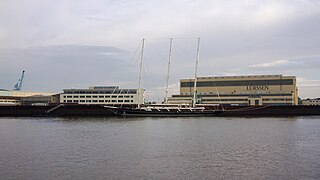HMAS Curlew was a Ton-class minesweeper operated by the Royal Navy from 1953 to 1961, and the Royal Australian Navy from 1962 to 1991. During her Australian service, the ship operated off Malaysia during the Indonesia–Malaysia confrontation during the mid-1960s, then was modified for use as a minehunter. Delays in bringing a replacement class into service kept Curlew operational until 1990, and she was sold into civilian service in 1991.

The Royal Malaysian Navy (RMN) is the naval arm of the Malaysian Armed Forces.
Navantia is a Spanish state-owned shipbuilding company, which offers its services to both military and civil sector. It is the fifth-largest shipbuilder in Europe, and the ninth-largest in the world with shipyards around Spain.

The Type 332 Frankenthal-class mine hunter is a class of German mine hunters. The ships are built of non-magnetic steel. Hull, machinery and superstructure of this class is similar to the original Type 343 Hameln-class minesweeper, but the equipment differs.

The Huon-class minehunter coastal (MHC) ships are a group of minehunters built for the Royal Australian Navy (RAN). Following problems with the Bay-class minehunters, a request for tender was issued in 1993 for a class of six coastal minehunters under the project designation SEA 1555. The tender was awarded in 1994 to the partnership of Australian Defence Industries (ADI) and Intermarine SpA, which was offering a variant of the Italian Gaeta-class minehunter.

The Belgian Navy, officially the Belgian Maritime Component of the Belgian Armed Forces, formerly the Belgian Naval Force, is the naval service of Belgium.

Type 320 Lindau-class minehunters was a class of German coastal minehunters built as part of the first FRG naval program. The ships were made from non-metallic components and built by Burmester Bremen. None of these ships now remain in service with the German Navy. Several went into service with the Estonian and Lithuanian Navy, as well as the Latvian Naval Forces. Flensburg and Weilheim became museum pieces.

HMS Pembroke is a Sandown-class minehunter of the Royal Navy. She was the second ship launched of the second batch of the class, which had several improvements over the first five ships built. The ship was posted for three years to the Persian Gulf between 2009 and 2012. Pembroke has since been deployed in international exercises and in historic ordnance detection in home waters.
The Karachi Shipyard & Engineering Works Limited (KS&EW), is a major defence contractor and military corporation situated in West Wharf in Karachi, Pakistan. It is the oldest and the only shipyard in Pakistan, catering for shipbuilding, ship repair and general heavy engineering. It has built numerous cargo ships, oil tankers, tugboats and support vessels, landing crafts, naval vessels and submarines for Pakistani Navy.
EML Sulev (M312) is a Lindau-class minehunter of the Estonian Navy Mineships Division. The commanding officer of the vessel is Lieutenant Janek Naur.

EML Wambola (M311) is a Lindau-class minehunter of the Estonian Navy Mineships Division, formerly the German warship Cuxhaven. The commanding officer of the vessel is Captain Jaanus Antson. The minehunter Wambola is the first vessel of the Estonian Navy Mineships Division and also the first modernized Lindau-class minehunter. A black keel on a silver background with a golden battle-axe is on the coat of arms of the vessel. The battle-axe is a weapon used by the ancient Estonians which also symbolizes their fighting spirit and strength. The ships motto is the Latin "Ad unquem" which is in English "Onto the nail head". The coat of arms was designed by Priit Herodes. In 2000 a cooperation contract was signed between the Pärnu city council and the minehunter Wambola which gave the vessel a right to wear the Pärnu town coat of arms and to introduce the city in all foreign harbors across the world.

The Morzh-class submarines were built for the Black Sea Fleet of the Imperial Russian Navy shortly before World War I.

Gölcük Naval Shipyard is a naval shipyard of the Turkish Navy within the Gölcük Naval Base on the east coast of the Sea of Marmara in Gölcük, Kocaeli. Established in 1926, the shipyard serves for the building and the maintenance of military vessels. A total of 3,221 personnel are employed at the shipyard stretching over an area of 255,526 m2 (2,750,460 sq ft) with covered structures of 121,466 m2 (1,307,450 sq ft).

HMAS Doomba was a Royal Australian Navy (RAN) warship of World War II. Built for the Royal Navy around the end of World War I as the Hunt-class minesweeper HMS Wexford, the ship only saw two years of service before she was decommissioned in 1921 and sold to the Doomba Shipping Company. The vessel was renamed SS Doomba, converted into a passenger ship, and operated in the waters around Brisbane until 1939, when she was requisitioned by the RAN for wartime service. Serving first as an auxiliary minehunter, then an auxiliary anti-submarine vessel, HMAS Doomba was purchased outright by the RAN in 1940, and served until early 1946, when she was sold and converted into a linseed oil lighter. Doomba was scuttled off Dee Why, New South Wales in 1976.

Imanta (M-04) is the lead ship of the Tripartite class of minehunters for the Latvian Naval Forces. The vessel was formerly HNLMS Harlingen (M854), an Tripartite-class minehunter of the Royal Netherlands Navy built in 1984. Alkmaar and Imanta are, respectively, the Dutch and Latvian navies' names of the Tripartite class of minehunters, developed jointly by France, Belgium, and the Netherlands.

LKL Kursis (M54) is a minehunter of the Lithuanian Naval Force. Built in West Germany in 1958 as Marburg (M1080), a Lindau-class minesweeper for the German Navy, she was upgraded to a Type 331 minehunter in the 1970s. Germany donated Marburg in 2001 to the Lithuanian Naval Force, which renamed the ship Kursis. The vessel augmented the Squadron of Mine-hunters, which had been established in 1999 with the similar donation of sister ship Koblenz, which became Sūduvis (M52).
Intermarine is an Italian shipbuilding company, owned by the Rodriquez Cantieri Navali Group.
















